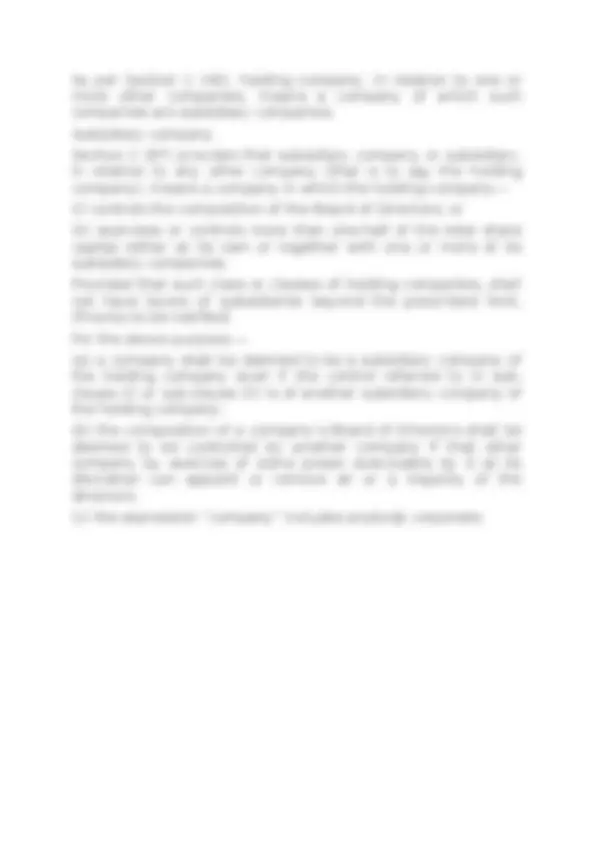



Study with the several resources on Docsity

Earn points by helping other students or get them with a premium plan


Prepare for your exams
Study with the several resources on Docsity

Earn points to download
Earn points by helping other students or get them with a premium plan
Community
Ask the community for help and clear up your study doubts
Discover the best universities in your country according to Docsity users
Free resources
Download our free guides on studying techniques, anxiety management strategies, and thesis advice from Docsity tutors
classification of a company on the basis of incorporation and holding and subsidary companies
Typology: Study notes
1 / 2

This page cannot be seen from the preview
Don't miss anything!


(i) Classification on the basis of Incorporation: There are three ways in which companies may be incorporated.
(a) Statutory Companies: These are constituted by a special Act of Parliament or State Legislature. The provisions of the Companies Act, 2013 do not apply to them. Examples of these types of companies are Reserve Bank of India, Life Insurance Corporation of India, etc.
(b) Registered Companies: The companies which are incorporated under the Companies Act, 2013 or under any previous company law, with ROC fall under this category.
(ii) Classification on the basis of Liability: Under this category there are three types of companies:
(a) Unlimited Liability Companies: In this type of company, the members are liable for the company’s debts in proportion to their respective interests in the company and their liability is unlimited. Such companies may or may not have share capital. They may be either a public company or a private company.
(b) Companies limited by guarantee: A company that has the liability of its members limited to such amount as the members may respectively undertake, by the memorandum, to contribute to the assets of the company in the event of its being wound-up, is known as a company limited by guarantee. The members of a guarantee company are, in effect, placed in the position of guarantors of the company’s debts up to the agreed amount.
(c) Companies limited by shares: A company that has the liability of its members limited by the memorandum to the amount, if any, unpaid on the shares respectively held by them is termed as a company limited by shares. For example, a shareholder who has paid 75 on a share of face value 100 can be called upon to pay the balance of `25 only. Companies limited by shares are by far the most common and may be either public or private.
On the basis of control companies can be classified into holding, subsidiary and associate companies.
Holding company
As per Section 2 (46), holding company, in relation to one or more other companies, means a company of which such companies are subsidiary companies.
Subsidiary company
Section 2 (87) provides that subsidiary company or subsidiary, in relation to any other company (that is to say the holding company), means a company in which the holding company—
(i) controls the composition of the Board of Directors; or
(ii) exercises or controls more than one-half of the total share capital either at its own or together with one or more of its subsidiary companies:
Provided that such class or classes of holding companies, shall not have layers of subsidiaries beyond the prescribed limit. (Proviso to be notified)
For the above purpose,—
(a) a company shall be deemed to be a subsidiary company of the holding company even if the control referred to in sub- clause (i) or sub-clause (ii) is of another subsidiary company of the holding company;
(b) the composition of a company’s Board of Directors shall be deemed to be controlled by another company if that other company by exercise of some power exercisable by it at its discretion can appoint or remove all or a majority of the directors;
(c) the expression “company” includes anybody corporate;